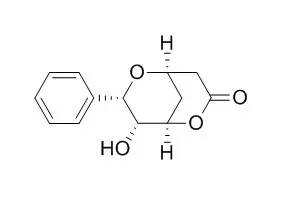| In vitro: |
| Molecules. 2012 Dec 21;18(1):128-39. | | Cytotoxic and antioxidant compounds from the stem bark of Goniothalamus tapisoides Mat Salleh.[Pubmed: 23344192] |
METHODS AND RESULTS:
Eleven compounds:goniomicin A (1), goniomicin B (2), goniomicin C (3), goniomicin D (4), tapisoidin (5), goniothalamin (6), 9-Deoxygoniopypyrone (7), pterodondiol (8), liriodenine (9), benzamide (10) and cinnamic acid (11), were isolated from the stem bark of Goniothalamus tapisoides. All compounds were identified by spectroscopic analysis and, for known compounds, by comparison with published data.
CONCLUSIONS:
Goniothalamin (6) exhibited mild cytotoxic activity towards a colon cancer cell line (HT-29), with an IC(50)value of 64.17 ± 5.60 µM. Goniomicin B (2) give the highest antioxidant activity in the DPPH assay among all compounds tested, with an IC(50) of 0.207 µM. | | J Nat Prod. 1991 Jul-Aug;54(4):1034-43. | | Two new styryl lactones, 9-deoxygoniopypyrone and 7-epi-goniofufurone, from Goniothalamus giganteus.[Pubmed: 1791471] |
METHODS AND RESULTS:
Two new styryl lactones, 9-Deoxygoniopypyrone [1] and 7-epi-goniofufurone [3], and a known styryl lactone, goniodiol [5], were isolated from the stem bark of Goniothalamus giganteus. The structures were elucidated by ir, ms, 1H-nmr, 13C-nmr, and 1H-1H COSY spectra; the relative configurations were determined by X-ray crystallographic analysis.
CONCLUSIONS:
Unlike goniopypyrone [2] and goniofufurone [4], neither of the new styryl lactones 9-Deoxygoniopypyrone and 3 showed significant bioactivities to human tumor cells. However, goniodiol [5] showed significant and selective cytotoxicity against human lung tumor cells (A-549). |
|






 Cell. 2018 Jan 11;172(1-2):249-261.e12. doi: 10.1016/j.cell.2017.12.019.IF=36.216(2019)
Cell. 2018 Jan 11;172(1-2):249-261.e12. doi: 10.1016/j.cell.2017.12.019.IF=36.216(2019) Cell Metab. 2020 Mar 3;31(3):534-548.e5. doi: 10.1016/j.cmet.2020.01.002.IF=22.415(2019)
Cell Metab. 2020 Mar 3;31(3):534-548.e5. doi: 10.1016/j.cmet.2020.01.002.IF=22.415(2019) Mol Cell. 2017 Nov 16;68(4):673-685.e6. doi: 10.1016/j.molcel.2017.10.022.IF=14.548(2019)
Mol Cell. 2017 Nov 16;68(4):673-685.e6. doi: 10.1016/j.molcel.2017.10.022.IF=14.548(2019)